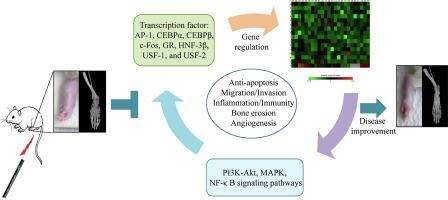Journal of Advanced Research ( IF 11.4 ) Pub Date : 2021-09-01 , DOI: 10.1016/j.jare.2021.08.015 Xi Chen 1 , Hui Zhang 1 , Wu Zeng 1 , Nick Wang 2 , Hang Hong Lo 1 , Chi Kio Ip 3 , Li Jun Yang 1 , W L Wendy Hsiao 1 , Wai Man Sin 4 , Chenglai Xia 5 , Betty Yuen Kwan Law 1 , Vincent Kam Wai Wong 1

|
Introduction
Far-infrared radiation (FIR) is widely used in the treatment of various diseases such as insomnia and cardiovascular risk. Rheumatoid arthritis (RA) is a chronic systemic autoimmune disease in which the therapeutic potential of FIR in RA is unclear.
Objectives
To determine the therapeutic potential and mechanistic actions of FIR in treatment of RA.
Methods
Adjuvant-induced arthritis (AIA) rat models were established to assess the therapeutic potency of FIR in RA treatment. The scoring parameters such as arthritis score, swelling of the hind paw, spleen and thymus indices, micro-CT analysis indices were adopted to estimate the beneficial effects of FIR during RA treatment in AIA model. PCR gene expression arrays were used to analyze inflammatory and autoimmune genes expression profiles in rat synovium. The inflammatory and immunity genes profiling was further analyzed through transcription factor prediction using PROMO. A signaling network map of possible molecular circuits connecting the identified differential genes to the RA's pathogenesis was constructed based on extensive literature reviews, and the major signaling pathways were validated by Western blotting.
Results
Thirty minutes of FIR treatment significantly improved the symptoms of AIA in rats. Gene expression profiling indicated that 27 out of 370 genes were down-regulated by FIR. AP-1, CEBPα, CEBPβ, c-Fos, GR, HNF-3β, USF-1, and USF-2 were predicted as key transcription factors that regulated the identified differential genes. In addition, MAPK, PI3K-Akt, and NF-κB signaling are the major molecular pathways down-regulated by FIR treatment.
Conclusion
FIR may provide beneficial effects on the AIA rat model of arthritis by suppression of the MAPK, PI3K-Akt and NF-κB signaling pathways. Therefore, we believe that FIR may provide an alternative non-pharmacological and non-surgical therapeutic approach for the treatment of RA.
中文翻译:

远红外线照射通过下调涉及炎症反应和自身免疫的基因来抑制大鼠实验性关节炎
介绍
远红外辐射(FIR)广泛用于治疗失眠和心血管风险等多种疾病。类风湿关节炎 (RA) 是一种慢性全身性自身免疫性疾病,其中 FIR 在 RA 中的治疗潜力尚不清楚。
目标
确定 FIR 在治疗 RA 中的治疗潜力和机制作用。
方法
建立了佐剂诱导的关节炎 (AIA) 大鼠模型以评估 FIR 在 RA 治疗中的治疗效力。在AIA模型中,采用关节炎评分、后爪肿胀、脾脏和胸腺指数、显微CT分析指数等评分参数来评估FIR在RA治疗中的有益效果。PCR 基因表达阵列用于分析大鼠滑膜中的炎症和自身免疫基因表达谱。通过使用 PROMO 的转录因子预测进一步分析炎症和免疫基因谱。基于广泛的文献综述,构建了将鉴定的差异基因与RA发病机制联系起来的可能分子回路的信号网络图,并通过Western印迹验证了主要信号通路。
结果
30 分钟的 FIR 治疗显着改善了大鼠 AIA 的症状。基因表达谱表明 370 个基因中有 27 个被 FIR 下调。AP-1、CEBPα、CEBPβ、c-Fos、GR、HNF-3β、USF-1 和 USF-2 被预测为调节已识别差异基因的关键转录因子。此外,MAPK、PI3K-Akt 和 NF-κB 信号传导是 FIR 处理下调的主要分子途径。
结论
FIR 可能通过抑制 MAPK、PI3K-Akt 和 NF-κB 信号通路对 AIA 大鼠关节炎模型产生有益影响。因此,我们认为 FIR 可能为 RA 的治疗提供一种替代的非药物和非手术治疗方法。











































 京公网安备 11010802027423号
京公网安备 11010802027423号